Medical compression molding can produce cost-effective rubber gaskets and rubber products for medical devices and equipment. It’s a good choice for very hard or difficult-to-flow materials because this molding method doesn’t need to push the rubber through sprues, gates, or runners. The Rubber Group provides compression molding along with injection molding and transfer molding services. Keep reading to learn more or contact The Rubber Group to discuss your application.
How does medical compression molding work?
Medical compression molding uses an uncured, pre-weighed elastomer that’s known as a pre-form. After the pre-form is placed in the mold’s cavity, the compression mold is closed and heat and pressure are applied. When the cavity is filled, excess rubber fills the mold’s overflow grooves. Later, after curing is complete and the compression mold is opened, deflashing is performed to remove any mold flash. Flashing is caused by material flowing out at the compression mold’s parting line.
How does vacuum compression molding help?
The Rubber Group performs compression molding in a vacuum chamber to enhance part quality and productivity. Not all compression molders have vacuum chambers, so our equipment provides us with a competitive advantage. Among its benefits, vacuum compression molding eliminates potential defects such as knit lines, air pockets, and other inclusions.
When is medical compression molding the best choice?
In addition to very hard or difficult-to-flow materials, medical compression molding is used with expensive elastomers, large parts, and low volume applications. Compared to commodity rubber, elastomers that meet USP Class VI or ISO 10993 testing requirements cost more because they are biocompatible. Additional uses for medical compression molding include rubber parts with very thick cross-sections that require long curing times. Medical injection molding is better for higher volumes and tighter tolerances. Transfer molding is better when tight control of dimensional tolerances is required.
What are some advantages of compression molding?
The advantages include lower tooling costs, faster lead times, lower material usage, and more cost-effective prototyping than other rubber molding methods. Compression molding is also suitable for most elastomers and curing systems. Silicone compression molding is common for medical applications, but many other types of rubber are also used.
What are some disadvantages of compression molding?
Compression molding is limited in terms of the precision and complexity that it can achieve. Often, medical parts that require complicated configurations or tight tolerances are better candidates for other rubber molding methods. For rubber gaskets and rubber products that require greater control and slightly more repeatability, part designers may want to use injection molding or transfer molding instead. Another disadvantage of compression molding is that it is slower and requires the pre-forming step, which adds costs to projects.
What are some applications for medical compression molding?
Medical compression molding is often used for prototyping and for lower-volume production. For example, silicone rubber can be compression molded into a prototype medical gasket for functional testing. Medical compression molding can also be used for production runs of diaphragms for respiratory equipment and the silicone face masks used with CPAP machines. Rubber-to-metal bonding is achievable, too. Additional applications include syringe stops, lip seals, and vibration isolators.
Is medical compression molding right for your specific application?
The Rubber Group is an ISO 9001:2015 certified company that can review your application requirements and recommend the best rubber molding process for your specific application: injection, transfer, or compression molding. We also offer design assistance and value-added services such as rapid prototyping, tooling, testing and performance evaluation, laser marking, packaging and shipping.
For more information, contact The Rubber Group.

